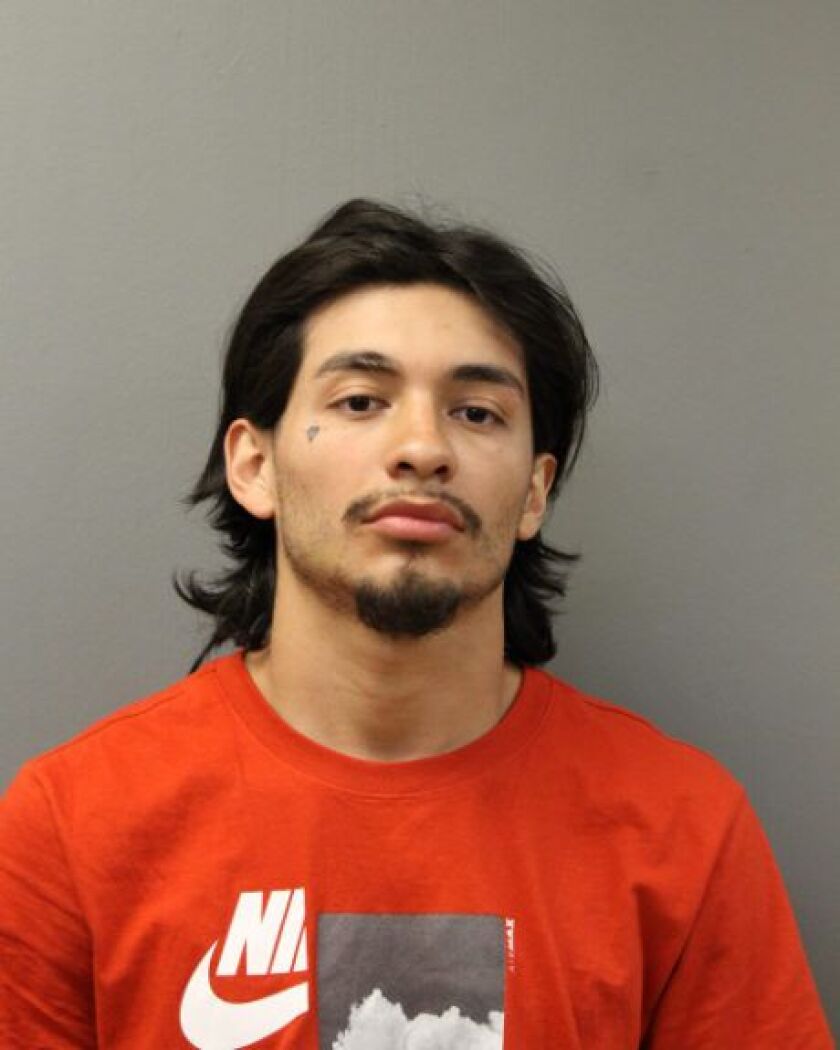The number of criminal defendants freed on bail and ordered to wear electronic-monitoring bracelets has soared this year in Cook County, including more than 1,000 people charged with murder, robbery or illegal possession of guns, a Chicago Sun-Times analysis has found.
Police Supt. David Brown says many of those being set free on electronic monitoring are responsible for the steep rise in killings this year in Chicago.
On Aug. 9, 43 people facing murder charges were in the county’s electronic-monitoring program — 40% more than on the same day last year.
Also in the program were 160 people charged with robbery and about 1,000 charged with illegal gun possession — twice as many for those crimes as on Aug. 9, 2019.
The Chicago Police Department has pointed to Cook County judges’ skyrocketing use of electronic monitoring as a key factor in the city’s shocking 50% rise in killings this year. Brown has hammered on that at news conferences following one violent weekend in Chicago after another, blaming a court system he has said won’t keep violent offenders behind bars.
After the Fourth of July weekend — when a 7-year-old girl and 14-year-old boy were among 17 people shot to death in Chicago — Brown said: “My hope is that the deaths of these young people will not be in vain and will prick the hearts of the decision-makers who release violent offenders on electronic monitoring back into these very communities to mete out this kind of violence every weekend.”
None of the three men now charged in 7-year-old Natalia Wallace’s death was on electronic monitoring when she was killed, court records show.
But the police point to other examples of people who’ve committed crimes while on electronic monitoring. And they cite others who they say shouldn’t have been placed in the program after being charged with violent acts.
Cook County State’s Attorney Kim Foxx is among county officials who’ve pushed back against the police department’s assertion that people free on bail are responsible for Chicago’s rise in violent crime.
Foxx says the statistics don’t back that up. For instance, Foxx says of the more than 1,800 arrests for illegal gun possession in the first six months of 2020, only a relative few — 26 — were “repeat offenders.”
Others say a decrease in police activity like arrests and traffic stops is also a likely factor in the rise in violence.
Chief Cook County Judge Timothy Evans says judges — who decide how much bail should be and can impose special conditions of bail including electronic monitoring — “must balance the right of the defendant to be presumed innocent with any evidence that the defendant would pose a real and present threat to the physical safety of any person.”
To protect the public, people charged with crimes who are granted bail with the condition they go on electronic monitoring typically are required to stay home except to go to work or school.
The number of people released with monitoring has risen this year because of the coronavirus pandemic, which has seen more detainees freed on bail to reduce the jail population to try to keep the virus from spreading.
More than 3,330 people are now in the county’s electronic-monitoring program, up from about 2,200 last year, according to Cook County Sheriff Tom Dart’s office, which is required to track them.
Nearly 5,000 others charged with crimes and awaiting trial are being held at the Cook County Jail, which has the capacity to hold twice as many people.
In 2016 and 2017, the most common charge being faced by suspects on electronic monitoring was drug possession.
Since 2018, the No. 1 charge has been gun possession, though it’s unclear whether a reform of the county’s bail system in 2017 had a role in that.
Under the reform, judges have been required to set bail felony defendants can afford to pay. The aim was to keep people who pose little risk to the public from languishing in jail because they are too poor to make bail.
Evans has said the reform hasn’t made Chicago more dangerous. He released a study last year that found people freed on bail weren’t responsible for rising violent crime.
“As the city continues to face violent weekends, blame is being placed on the pretrial justice practices in the Circuit Court of Cook County,” Evans wrote in a Sun-Times opinion piece last year. “The criticism is misleading because pretrial defendants released on bond are not driving the weekend crime statistics. In fact, 99.8% of felony defendants released on bail do not receive charges of new gun-related violent crime while their cases are pending.”
But criminologists then published a paper that refuted Evans’ analysis, saying his study’s methodology was flawed and that violent crime had, in fact, increased significantly as a result of the bail reform.
One factor that Foxx and Evans haven’t taken into account in their statistics is the police department’s low rate of solving shootings. People freed on bail and ordered to wear electronic-monitoring bracelets could be shooting other people but just not getting caught.
The Sun-Times asked the police department for data showing any links between violent crime and people on electronic monitoring.
The department responded with examples — a list of 29 people that Brown has used to criticize the electronic-monitoring program.
The list included:
- Chrishawn Thomas, 18, who’s accused of jumping from a stolen GMC truck and robbing a female driver at gunpoint in March in Logan Square, taking her iPhone X, AirPods, wallet and house keys. The police arrested Thomas near the Parkway Gardens housing complex on the South Side after, they say, he rammed their vehicle with the stolen truck. Charged with armed robbery, he posted $500 in bail and was placed on electronic monitoring in early April. On June 9, the sheriff’s office received an alert for an “unauthorized leave” by Thomas from his electronic monitoring. Three hours later, he shot an off-duty Chicago cop in a knee during an attempted robbery and the officer returned fire, hitting Thomas in the legs, police say. Thomas was arrested at a hospital the next day and is being held without bail.
- Dimitris Horns, 18, who was arrested in February in Englewood for possessing a firearm illegally. Police said they saw a bulge under Horns’ sweatshirt and that he ran when they approached him and tossed a .40-caliber handgun during the chase. Horns posted $500 to get out of jail on bail and was placed on electronic monitoring. In late May, sheriff’s officials in the electronic-monitoring unit got an alert about Horns’ bracelet being tampered with and Horns being on unauthorized leave. He was declared a fugitive after investigators visited his home and found his cut-off bracelet. On July 8, the police say he shot a man in the face during a robbery of $130 in Englewood. He was charged with aggravated battery, armed robbery and escape.
- Omar Guzman, 24, who was convicted of illegal gun possession in 2014 and 2017 and was arrested in late 2019 on a charge of being an armed habitual criminal. This February, he posted $2,500 bail and was freed on electronic monitoring. In May, police officers said they caught Guzman with a gun in North Austin. He again was charged with being an armed habitual offender. He was placed on electronic monitoring again after posting $10,000 bail. On July 10, sheriff’s officials got an alert for his unauthorized leave, but his monitoring device showed he was back in his residence that night. The next morning, sheriff’s officials visited his home and gave him a warning. In July, Guzman was charged with failing to register as a gun offender. He remains on electronic monitoring.
- Leoji Allen, 21, who was charged with an armed robbery in January and placed on electronic monitoring after posting $1,000 bail. Five days later, prosecutors charged Allen with a separate armed robbery that had taken place in December. Allen then posted $2,500 bail in the December holdup. He’s remained on electronic monitoring since January.
Dart’s staff says the sheriff doesn’t think that people who, like Allen, have been charged with violent crimes should be freed on electronic monitoring while awaiting trial.
“The sheriff has long voiced his concern that EM should not be used for individuals who are charged with violent crimes — up to and including murder — and that it should be reserved for those facing low-level, nonviolent crimes,” the sheriff’s spokesman Matt Walberg says.
“The purpose of electronic monitoring was never to replace pretrial detention for violent offenders but to reduce overcrowding by releasing individuals who pose no risk to their communities to home supervision,” Walberg says.
Dart had tried to keep people charged with violent crimes from going free on electronic monitoring, but the federal appeals court in Chicago found that only judges can decide the conditions for granting bail and that the sheriff must follow them, according to Walberg.
He says the vastly expanded imposition of electronic monitoring has put a strain on the sheriff’s office.
“We have not received any additional financial or human resources to meet that demand,” Walberg says.
To better track people in the program, the sheriff’s office is shifting from electronic-monitoring equipment that operates on radio frequencies to bracelets that are tracked via global-positioning satellites.
The new system doesn’t require sheriff’s employees to set up control boxes in the homes of people on monitoring, according to the sheriff’s office, and the GPS technology will allow messages to be sent through a bracelet if a person isn’t following the rules.
















